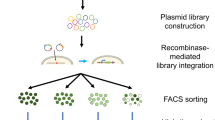Abstract
Genomics-based approaches are increasingly being used to identify disease-associated genes that represent potential new drug targets. As a first step in the validation of genes of unknown function, we describe a method for rapidly determining the subcellular localization of the gene product. If an immunotherapeutic approach is being considered, it is of particular interest to identify targets that are either on the cell-surface or secreted. Transient expression in COS cells combined with immunofluorescent staining provides a semi-high throughput method for determining the subcellular localization of multiple targets in parallel. COS cells are ideal for this purpose since: (i) they transfect easily; (ii) the high levels of expression that can be achieved transiently allow detection after 24 h; and (iii) the relatively large size and spread morphology of these cells allows the subcellular organelles to be easily visualized. To evaluate the system, we show prototype staining patterns for known cytoplasmic,secreted, Golgi-associated, endoplasmic reticulum-associated, and plasma membrane proteins, as well as data for novel targets. The localization of novel secretory and cell-surface proteins as determined by immunofluorescent staining, was confirmed by independent methods.
Similar content being viewed by others
References
Brodsky JL & McCracken AA (2000) ER protein quality control and proteasome-mediated protein degradation. Semin Cell Dev Biol 5: 507–513.
Bock JB (1996) A new syntaxin family member implicated in targeting of intracellular transport vesicles. J Biol Chem 271: 17961–17965.
Caras IW, Weddell GN & Williams SR (1989) Analysis of the signal for attachment of a glycophospholipid membrane anchor. Cell Biol 108: 1387–1396.
Cole SR, Ashman LK & Ey PL (1986) Biotinylation: an alternative to radioiodination for the identification of cell surface antigens in immunoprecipitates. Mol Immunol 24: 699–705.
Davitz MA, Low MG & Nussenzweig V (1986). Release of decay-accelerating factor (DAF) from the cell membrane by phosphatidylinositol-specific phospholipase C (PIPLC). Selective modification of a complement regulatory protein. J Exp Med 163: 1150–1161.
Gimelbrant AA, Stoss TD, Landers TM & McClintock TS (1999) Truncation releases olfactory receptors from the endoplasmic reticulum of heterologous cells. J Neurochem 72: 2301–2311.
Gluzman Y (1981) SV40-transformed simian cells support the replication of early SV40 mutants. Cell 23: 175–182.
Kahne T & Ansorge S (1994) Non-radioactive labelling and immunoprecipitation analysis of leukocyte surface proteins using different methods of protein biotinylation. J Immunol Methods 168: 209–218.
Klumperman J (2000) Transport between ER and Golgi. Curr Opin Cell Biol 4: 445–449.
Mellon P, Parker V, Gluzman Y & Maniatis T (1981) Identification of DNA sequences required for transcription of the human alpha 1-globin gene in a new SV40 host-vector system. Cell 27: 279–288.
Nakamura N, Lowe M, Levine TP, Rabouille C & Warren G (1997) The vesicle docking protein p115 binds GM130, a cis-Golgi matrix protein, in a mitotically regulated manner. Cell 89: 445–455.
Rothman JE (1994) Mechanisms of intracellular protein transport. Nature 372: 55–63.
Rothman JE & Wieland FT (1996) Protein sorting by transport vesicles. Science 272: 227–234.
Simpson JC, Wellenreuther R, Poustka A, Pepperkok R & Wiemann S (2000) Systematic subcellular localization of novel proteins identified by large-scale cDNA sequencing. EMBO reports 1: 287–292.
Author information
Authors and Affiliations
Corresponding author
Rights and permissions
About this article
Cite this article
Simon, I., Wright, M., Flohr, T. et al. Determining subcellular localization of novel drug targets by transient transfection in COS cells. Cytotechnology 35, 189–196 (2001). https://doi.org/10.1023/A:1013152432069
Issue Date:
DOI: https://doi.org/10.1023/A:1013152432069




